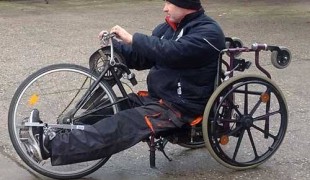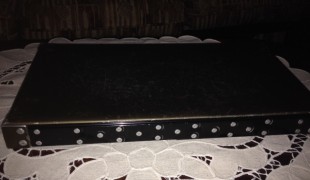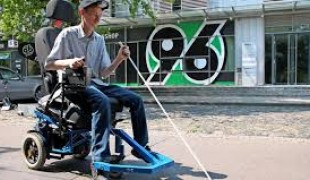- 6740
- 369
- 5
- 3
- 0
- Help Ukraine
About the solution
Jon had the idea for this invention while rowing at Diver Lake Park, in Nainaimo, British Columbia, after seeing men in wheelchairs casting lines from the accessible fishing dock.
“Too bad they couldn’t be out bobbing in a canoe or rowing their way around the calm waters”, Jon thought. And that’s when he thought he could make this happen.
“I gasp and look to the sky in amazement. I know it will work even before testing my theory”, the inventor shared.
Then he started building the prototypes. This was the first version: Take any two canoes and lay five 12-foot planks fastened together as a breakaway 5-piece dock. The wheelchairs can be rolled onto the platform (even from a shoreline) and paddlers in the canoe are stationed on each of the four corners rowing the vessel. The chair bound passenger sits atop — with a spouse, a child or a loyal dog — feeling exactly as if atop a 10×12 foot floating dock. Other models use three canoes and a trolling motor to power the makeshift catamaran.
Another basic and different prototype for getting wheelchairs on the water uses a rowboat. Jon calls it the Chairower and it uses a short interior ramp descending into the hull: “Just roll on, and cast off.” To develop the craft, which should easily pass national safety regulations, Jon needed to make modifications to raise the oar height using extenders.
“It’s been amazing putting a fishing rod into the hands of someone who hasn’t been on the water in 10 or 12 years,” the innovator noted.
Jon started testing his different prototypes via a resource group called Access Nanaimo. The feedback from the users has been positive.
Adapted from: http://www.goodnewsnetwork.org/canoeing-for-all-introduction/
What about you, do you have any solutions? Please share them with the Patient Innovation community!
https://www.youtube.com/watch?v=thk_B9eU54Y
This solution shall not include mention to the use of drugs, chemicals or biologicals (including food); invasive devices; offensive, commercial or inherently dangerous content. This solution was not medically validated. Proceed with caution! If you have any doubts, please consult with a health professional.
DISCLAIMER: This story was written by someone who is not the author of the solution, therefore please be advised that, although it was written with the utmost respect for the innovation and the innovator, there can be some incorrect statements. If you find any errors please contact the patient Innovation team via info@patient-innovation.com
-
-
465
-
0
-
7524

Wheelchair cart
MOVING IN A WHEELCHAIR: Moving using a wheelchair.
Spinal Cord and Nerve Root Disorders
Limb Amputation
Cervical spinal cord injury/Tetraplegia
Walking Aid (wheelchair/walker/crutches)
Assistive Daily Life Device (to help ADL)
Difficulty walking or moving
Muscle weakness
Difficulty coordinating movements
Stiffness or rigidity (difficulty moving)
Paralysis of the legs and lower body
Limited range of motion
Restoring mobility
Promoting inclusivity and social integration
Preventing (Vaccination, Protection, Falls, Research/Mapping)
Neurology
Orthopedics
Germany
-
-
-
231
-
0
-
3411

Step articulated and mobile
MOVING IN A WHEELCHAIR: Moving using a wheelchair.
Traveling
Urban exploration
Paralysis
Assistive Daily Life Device (to help ADL)
Walking Aid (wheelchair/walker/crutches)
Restoring mobility
Promoting self-management
Managing Neurological Disorders
Building Supportive Community Relationships
Promoting inclusivity and social integration
Recovering from Traumatic Injuries
Maintaining Balance and Mobility
To improve Treatment/Therapy
Raise awareness
Caregiving Support
Neurology
Orthopedics
Rheumatology
Portugal
-
-
-
331
-
0
-
5145

Visually impaired creates E-car to help the blind
MOVING IN A WHEELCHAIR: Moving using a wheelchair.
Traveling
Blindness
Paralysis
Cervical spinal cord injury/Tetraplegia
Walking Aid (wheelchair/walker/crutches)
Assistive Daily Life Device (to help ADL)
Vision problems
Paralysis of the legs and lower body
Restoring mobility
Promoting self-management
Promoting inclusivity and social integration
Preventing (Vaccination, Protection, Falls, Research/Mapping)
Neurology
Ophthalmology
Orthopedics
Germany
-
 en
en